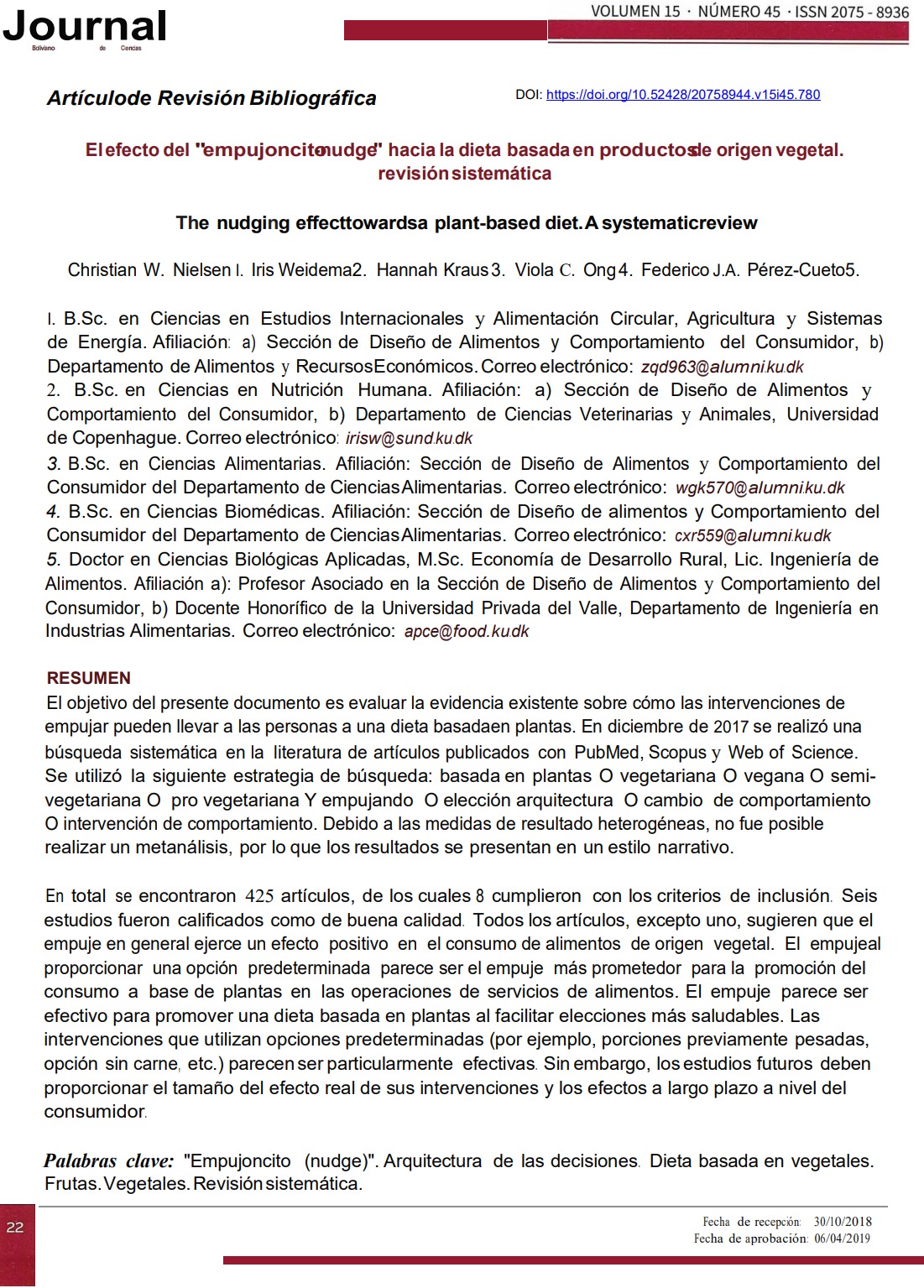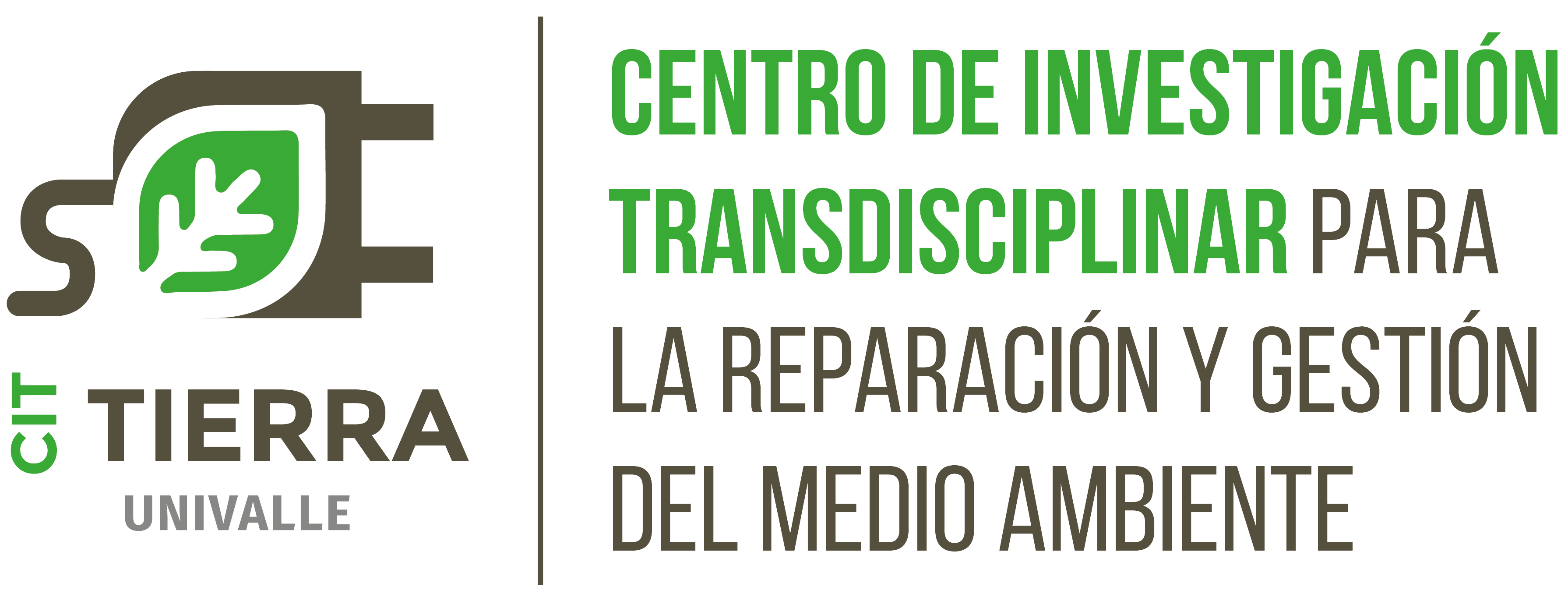The Nudging Effect Towards a Plant-Based Diet. A Systematic Review
DOI:
https://doi.org/10.52428/20758944.v15i45.780Keywords:
Nudge Choice Architecture, Plant-Based Diet, Fruits, Vegetables, Systematic ReviewAbstract
The aim of this paper is to assess existing evidence on how nudge (gentle push) interventions can lead people to a plant-based diet. In December 2017 a systematic literature search of articles published with PubMed, Scopus and Web of Science was carried out. The following search strategy was used: plant-based OR vegetarían OR vegan OR semi-vegetarían OR pro-vegetarian AND nudging OR choice architecture OR behavioral change OR behavioral intervention. Due to heterogeneous outcome measures, it was not possible to perform a meta-analysis, so the results are presented in a narrative style. A total of 425 articles were found, of which 8 met the inclusion criteria. Six studies were rated as of good quality. Ali the articles, except one, suggest that the push in general exerts a positive effect on the consumption of foods of vegeta ble origin. The nudge, to provide a predetermined option, seems to be the most promising for the promotion of plant-based consumption in food service operations. Nudging appears to be effective in promoting a plant-based diet by facilitating healthier choices. lnterventions that use predetermined options (for example, previously weighed portions, option without meat, etc.) seem to be particularly effective. However, future studies should provide the size of the actual effect of their interventions and the long-term effects at the consumer level.
Downloads
References
Boeing, H., Bechthold, A., Bub, A., Ellinger, S., Haller, D., Kroke, A., Leschik-Bonnet, E., Müller, M.J.,
Oberritter, H., Schulze, M., Stehle, P. y Watzl, B. (2012). Critica! review: vegeta bles and fruit in the prevention of chronic diseases. European Journal of Nutrition. 51(6): 637-663 https://doi.org/10.1007/s00394-012-0380-y
Broers, V.J.V., De Breucker, C., Van den Broucke, S. y Luminet, O. (2017). A systematic review and meta-analysis of the effectiveness of nudging to increase fruit and vegeta ble choice. European Journal of Public Health. 27(5): 912-920. https://doi.org/10.1093/eurpub/ckx085
Campbell, V., Arvai, J. y Kalof, L. (2014). Motivating sustainable food choices. Environment and behavior. 46(4): 453-475. https://doi.org/10.1177/0013916512469099
Carfora, V., Caso, D. y Conner, M. (2017). Randomized controlled trial of a text messaging intervention for reducing processed meat consumption: The mediating roles of anticipated 10 regret and intention. Appetite. 117, p. 152-160. https://doi.org/10.1016/j.appet.2017.06.025
Carfora, V., Caso, D. y Conner, M. (2016). Randomized controlled tria! of a messaging intervention to increase fruit and vegeta ble intake in adolescents: Affective versus instrumental messages. British journal of health psychology. 21(4): 937-955. https://doi.org/10.1111/bjhp.12208
Cohen, J.F.W., Richardson, S.A., Cluggish, S.A., Parker, E., Catalano, P.J. y Rimm, E.B. (2015). Effects of choice architecture and chef-enhanced mea Is on the selection and consumption of healthier school foods: a randomized clinical trial. JAMA pediatrics. 169(5): 431-437. https://doi.org/10.1001/jamapediatrics.2014.3805
Correia, D.C.S., O'Connell, M., lrwin, M.L. y Henderson, K.E. {2014). Pairing vegeta bles with a liked food and visually appealing presentation: promising strategies for increasing vegeta ble consumption among preschoolers. Childhood obesity {Print).10(1): 72-76. https://doi.org/10.1089/chi.2013.0115
Ensaff, H., Coan, S., Sahota, P., Braybrook, D., Akter, H. y Mcleod, H. 2015. Adolescents' Food Choice and the Place of Plant-Based Foods. Nutrients. 7(6): 4619-4637. (B) https://doi.org/10.3390/nu7064619
Ensaff, H., Homer, M., Sahota, P., Braybrook, D., Coan, S. y Mcleod, H. (2015). Food Choice Architecture: An lntervention in a Secondary School and its lmpact on Students' Plant-based Food Choices. Nutrients. 7(6): 4426-4437. (A) https://doi.org/10.3390/nu7064426
Friis, R., Skov, L.R., Olsen, A., Appleton, K.M., Saulais, L., Dinnella, C., Hartwell, H., Depezay, L., Monteleone, E., Giboreau, A. y Perez-Cueto, F.J.A. 2017. Comparison of three nudge interventions (priming, default option, and perceived variety) to promote vegetable consumption in a self-service buffet setting. Plus One 12(5): e0l76028. https://doi.org/10.1371/journal.pone.0176028
Hansen, P.G. y Jespersen, A.M. (2013). Nudge and the manipulation of choice. European Journal of Risk Regulation 4(01): 3-28. https://doi.org/10.1017/S1867299X00002762
Hoefkens, C., Lachat, C., Kolsteren, P., Van Camp, J. y Verbeke, W. (2011). Posting point-of-purchase nutrition information in university canteens does not influence meal choice and nutrient intake. The American Journal of Clínica[ Nutrition. 94(2): 562-570. https://doi.org/10.3945/ajcn.111.013417
Hoek, A.C., Luning, P.A., Weijzen, P., Engels, W., Kok, F.J. y de Graaf, C. (2011). Replacement of meat by meat substitutes. A survey on person and product-related factors in consumer acceptance. Appetite. 56(3): 662-673. https://doi.org/10.1016/j.appet.2011.02.001
House of Lords (2011). Behaviour Change. London: Authority of the House of Lords.
Just, D. y Wansink, B. (2009). Smarter lunchrooms: using behavioral economics to improve meal selection. Choices, the magazine of food, farm and resource issues. 24(3). https://doi.org/10.1096/fasebj.24.1_supplement.322.1
Lea, E.J., Crawford, D. y Worsley, A. (2006). Consumers' readiness to eat a plant-based diet. European Journal of Clinical Nutrition. 60(3): 342-351. https://doi.org/10.1038/sj.ejcn.1602320
McEvoy, C.T., Temple, N. y Woodside, J.V. (2012). Vegetarían diets, low-meat diets and health: a review. Public Health Nutrition. 15(12): 2287-2294. https://doi.org/10.1017/S1368980012000936
Nernberg, T.R., Houlby, L., Skov, L.R. y Peréz-Cueto, F.J.A. (2016). Choice architecture interventions for increased vegeta ble intake and behaviour change in a school setting: a systematic review. Perspectives in public health. 136(3): 132-142. https://doi.org/10.1177/1757913915596017
Reinders, M.J., Huitink, M., Dijkstra, S.C., Maaskant, A.J. y Heijnen, J. (2017). Menu-engineering in restaurants - adapting portian sizes on plates to enhance vegeta ble consumption: a real-life experiment. The lnternational Journal of Behavioral Nutrition and Physical Activity. 14(1): 41. https://doi.org/10.1186/s12966-017-0496-9
Thaler, R.H. y Sunstein, C.R. 2009. Nudge, lmproving Decisions About Health, Wealth, and Happiness. (16 Ed.) New York: Penguin Books.
Visschers, V.H.M. y Siegrist, M. 2015. Does better for the environment mean less tasty? Offering more climate-friendly meals is good for the environment and customer satisfaction. Appetite. 95, p. 475483. https://doi.org/10.1016/j.appet.2015.08.013
Wansink, B. (2015). Change Their Choice! Changing Behavior Using the CAN Approach and Activism Research. Psychology and Marketing 32(5): 486-500. https://doi.org/10.1002/mar.20794
Westhoek, H., Lesschen, J.P., Rood, T., Wagner, S., De Marco, A., Murphy-Bokern, D., Leip, A., van Grinsven, H., Sutton, M.A. y Oenema, O. (2014). Food choices, health and environment: Effects of cutting Europe's meat and dairy intake. Global Environmental Change. 26, p. 196-205. https://doi.org/10.1016/j.gloenvcha.2014.02.004

Downloads
Published
How to Cite
Issue
Section
License
Copyright (c) 2019 Christian W. Nielsen, Iris Weidema, Hannah Kraus y Federico J.A. Pérez-Cueto

This work is licensed under a Creative Commons Attribution 4.0 International License.
Authors who publish with this journal agree to the following terms:
- Authors retain copyright and grant the journal right of first publication with the work simultaneously licensed under a Creative Commons Attribution License 4.0 that allows others to share the work with an acknowledgement of the work's authorship and initial publication in this journal.
- Authors are able to enter into separate, additional contractual arrangements for the non-exclusive distribution of the journal's published version of the work (e.g., post it to an institutional repository or publish it in a book), with an acknowledgement of its initial publication in this journal.
- Authors are permitted and encouraged to post their work online (e.g., in institutional repositories or on their website) prior to and during the submission process, as it can lead to productive exchanges, as well as earlier and greater citation of published work.














